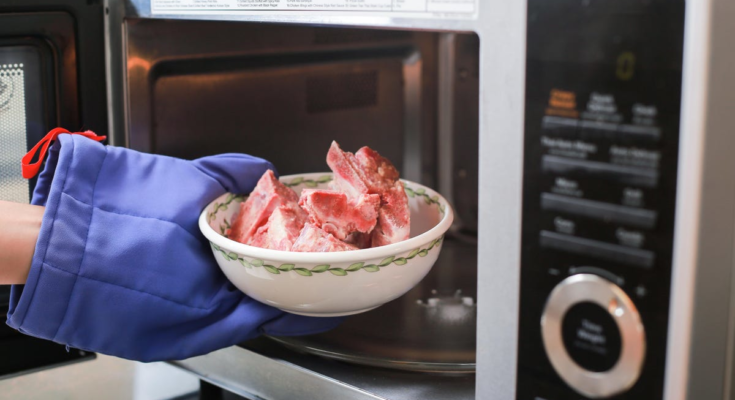
I love having a microwave. I use mine to whip up mashed potatoes, roux for gumbo, even lemon curd. It’s a versatile appliance, and I think everyone should have one. I’m not, however, in love with its defrost function.
How does a microwave’s defrost function work?
Before we get into why the microwave’s defrost function kind of sucks, let’s talk about how it works. All microwave ovens are equipped with magnetrons, which are not a kind of Transformer, but a device that emits electromagnetic (micro) waves. These waves oscillate quickly—about a billion times per second—causing the water molecules in your food to rotate at a similar clip to align themselves with the magnetic field. This rapid rotation increases their temperature and heats your food.
According to Cook’s Illustrated, unless you have a fancy and expensive science oven, the intensity of this radiation cannot be decreased (or increased):
Here’s the catch: In most microwave ovens, because the magnetron is designed to emit a single wavelength, the intensity of the radiation can’t be altered. It can, however, be turned on and off, and that’s exactly what power levels do. When you lower the power level in a microwave oven, you decrease the amount of time the magnetron stays on.
Cook’s Illustrated goes on to explain that microwaves “penetrate only the outer ¼ to 1 inch of food,” which “can quickly superheat these regions.” Turning the radiation off and on gives the heat a chance to disperse to the center of the food, gradually heating your frozen block of stew without cooking the outer layer (hopefully). But even with these fluctuations, microwave thawing has some problems.
Microwaves aren’t great at melting ice
Ice is water in its solid state, but its unique crystal structure makes it difficult to melt with microwave radiation. According to thenakedscientists, this structure keeps the water molecules from rotating like they do in their liquid state:
In ice the water molecules are all locked together in a crystal structure by hydrogen bonds. These bonds will stop the water molecules rotating, which means they can’t absorb much energy from the microwaves. This, in turn, means that the ice doesn’t heat up.
Some of the ice will eventually melt—it’s not in a freezer, after all—and those exterior liquid water molecules will start to rotate, which can lead to cooked outsides and raw, partially or fully frozen insides, especially if you try and thaw something on “full” power. This is, at best, gross and, at worse, dangerous, depending on what you’re trying to thaw.
This is why those breaks in radiation are programmed into the defrost function—they allow the heat generated by the rotating liquid water molecules to thaw their frozen neighbors.
This works well enough for some foods, like soup, casseroles, gravy, etc., but it’s not a great match for frozen meat. You can get away with smaller, thinner cuts, but I would never attempt to thaw a two-inch ribeye in the microwave. Even with those pauses in power, you’re going to end up with an exterior that sees a lot more radiation than the interior. Factor in the irregular shape of a chicken breast, and you have a recipe for rubbery, partially-cooked spots and exteriors.
The best way to defrost meat
The best, safest way to thaw frozen meat is to leave it in the fridge overnight. Leaving it at room temperature may be tempting, but it’s not safe, as your food will have to hang out in the bacteria-loving “danger zone.” If you need to speed things up, you can submerge your (wrapped) meat in cold water, and replace the water every half hour until your meat is thawed (this can take half an hour to an hour per pound).
If you’re working with thin cuts, you can use a hot water bath to thaw steaks, chops, and tenders in a matter of minutes, which isn’t enough time for harmful bacteria to grow. (Just make sure to cook your meat immediately to get it out of the danger zone.) You can also speed things up with an immersion circulator. (You can also cook meat from frozen in an immersion circulator—an extra half hour or so should do it, depending on the cut.)




One thing I would really like to say is the fact before getting more computer memory, consider the machine into which it can be installed. In case the machine is usually running Windows XP, for instance, the actual memory threshold is 3.25GB. Using above this would purely constitute a new waste. Make sure that one’s motherboard can handle the upgrade quantity, as well. Interesting blog post.
I used to be recommended this web site via my cousin. I’m no longer positive whether or not this submit is written by means of him as no one else know such unique about my difficulty. You are amazing! Thanks!